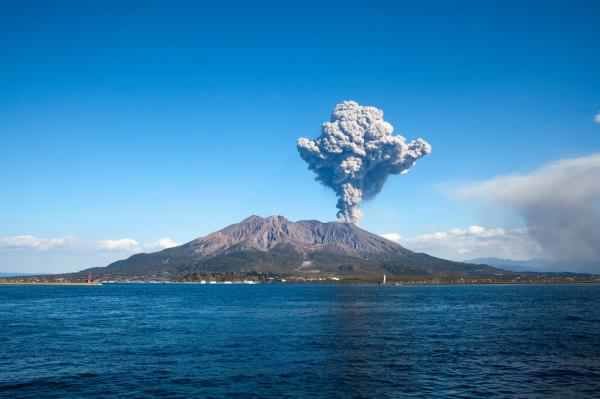
The overflow of magma filled the narrow strait separating the volcanic island from southwestern Japan's Osumi Peninsula, causing flooding in the city of Kagoshima, which has since been nicknamed the "Naples of the Eastern World."
Recently, a team of researchers from the University of Exeter and University of Bristol developed a new method for imaging the underground plumbing system that supplies Sakurajima with its molten rock.
The results of their imaging survey were published this week in the journal Scientific Reports.
"What we have discovered is not just how the magma flows into the reservoir, but just how great the reservoir is becoming," lead researcher James Hickey said in a news release.
"We believe that this new approach could help to improve eruption forecasting and hazard assessment at volcanoes not just in this area, but worldwide," Hickey added. "We know that being forewarned means we are forearmed and providing essential information for local authorities can potentially help save lives if an eruption was imminent."
The survey -- powered by a combination of GPS sensors and computer models -- focused on Aira caldera, a deep crater formed from a collapsed magma chamber. The crater now serves as a holding area, or shallow reservoir, for Sakurajima's magma.
The latest imagery revealed to scientists, for the first time, the plumbing that fills the Aira chamber with magma. According to the new analysis, the plumbing system pumps another 14 million cubic meters of magma into the Aira chamber every year.
Over the last several decades, Sakurajima has remained constantly active. Its unceasing plume of ash is periodically accented by small eruptions. But the new study suggests Aira is being filled at a faster rate than Sakurajima can release via small eruptions. In other words, pressure is building.
"The 1914 eruption measured about 1.5 kilometers cubed in volume -- a massive event," Hickey explained. "From our data we think it would take around 130 years for the volcano to store the same amount of magma for another eruption of a similar size -- meaning we are around 25 years away."
"By identifying a time frame over which we may see an increase in the level of activity at the volcano our colleagues at the Sakurajima volcano research center can plan accordingly," he continued. "The numerical constraints we were able to put on the magma supply conditions can also be used to assist with probabilistic and quantitative eruption forecasting."
Though the latest study offers alarming news for the residents of Kagoshima, the results do hold promise for the future of eruption forecasting at active volcanoes around the world.
"A thorough understanding of the rate and volume of magma supply and accumulation, and their thermomechanical controls, is essential for continued monitoring and eruption forecasting at Sakurajima volcano, and volcanoes worldwide," concluded Bristol researcher and study co-author Joachim Gottsmann.



"The 1914 eruption measured about 1.5 kilometers cubed in volume -- a massive event," Hickey explained. "From our data we think it would take around 130 years for the volcano to store the same amount of magma for another eruption of a similar size..."
There are so many changes occurring that effect our planet, to assume the same time frame between events as in the past may be a fatal error. Changes seem to be speeding up.